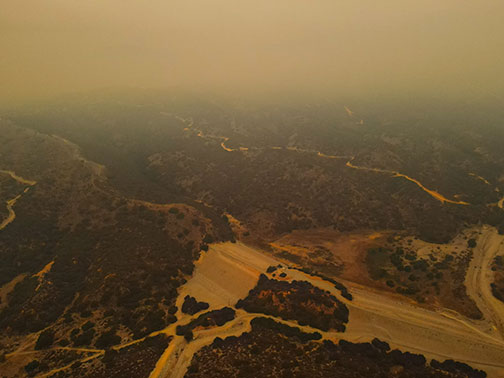Wilderness Park: Why does it close so often?

by Mick Rhodes | mickrhodes@claremont-courier.com
Though Claremont’s skies were noticeably clearer this week, prompting the city to reopen the Wilderness Park on Wednesday, the weekend forecast is unfortunately calling for more very unhealthy air.
Monday and Tuesday’s air quality index numbers were 99 and 38, respectively. But the slide began Wednesday when the air was forecast as “moderate” at 96, with Thursday predicted to be 140 and “unhealthful for sensitive groups.” Today’s forecast is even worse, calling for a “very unhealthful” reading of 217. Tomorrow’s is nearly as toxic, at 214.
Smoke from the nearby Bobcat Fire burning above Azusa (and to a lesser degree, the Yucaipa El Dorado Fire) has blanketed town since it began on Sunday, September 6, the hottest day in Los Angeles County’s recorded history, when temperatures hit an unbelievable 121 in Chino and Woodland Hills.
Since then the South Coast Air Quality Management District has issued warning after warning regarding unhealthy oxygen in the area, and the city closed the popular Wilderness Park due to the proximity of the Bobcat Fire and the associated unhealthy air.

A fire within 10 miles of the Wilderness Park is one of the events that will cause its closure, Ms. Handel said. Other considerations are high winds, extreme heat and poor air quality, the lot of which coalesced on September 6.
“Since the Bobcat Fire we’ve had that perfect storm of bad conditions for the Wilderness Park,” said Ms. Handel, who has been on the job for a decade. “It has tested my communication skills. You think you’re prepared, you’ve been through a lot of crisis management through the state and everything for handing crisis communication, and it is like everything that they told you and more that I’ve had to deal with this summer. It is unbelievable. And we’re learning in on the fly. Ha-ha! And then the earthquake, right? Ha-ha! I don’t want to jinx it and say what more could happen.”
The Wilderness Park is the most environmentally sensitive city-managed recreational destination, so it would follow that it would be first to close.
“We’re not going to take that risk,” Ms. Handel said. “It’s a heavily populated, heavily used location, and we’re not going to put all those people up there in the heat and have them have heatstroke. We’re not going to make it unhealthy for people to be up there.”
Another factor is the park’s relatively remote location.
“We need to be sure we can access people quickly if winds shift and fires change,” Ms. Handel said. “We need people to evacuate it quickly. And that’s a five mile loop depending on where you are and how fast you hike. It can take you a whole hour to get out of that Wilderness Park.”
The nearby Thompson Creek Trail, which runs 2.8 miles, covering 24.9 linear acres, is a different animal.
“There’s so many access points, you can get people off quickly,” Ms. Handel said. “It’s a little different. Now, we will close it when it’s really, really hot.”
Skies were actually somewhat blue on Monday and Tuesday, with Claremont’s first two days of “moderate” and “good” air, respectively, according to IQAir, the world’s largest free real-time air quality information platform.
Check the air before going outside
IQAir provides an air quality index score, updated throughout the day, for communities around the world via its 80,000-plus PM2.5 sensors, five of which are located in Claremont.
To see IQAir’s current Claremont air quality numbers, go to: https://www.iqair.com/us/usa/california/claremont?utm_source=homepage_-usa-california-claremont&fbclid=IwAR2jAZD92ge0iOOKVCnJr1YNTZHhQ7_4FIKHkuCFCTIQaGvSRoroW871Rr0.
For residents who want updates on park closures in Claremont, Ms. Handel recommends checking the city’s social media accounts on Facebook and Instagram, or its website at https://www.ci.claremont.ca.us for notifications or to sign up to receive an email notifications from the city.
“Before they head out to the Wilderness Park to just do a doublecheck, because of the fires right now especially,” she said. “We’d hate for them to get out the park and have to turn around and go home.”
The Bobcat Fire, burning north of Azusa, had taken 113,307 acres as of 12:30 p.m. Wednesday, with 38 percent containment. Current information on the Bobcat Fire can be found at Inciweb, an interagency all-risk incident information management system, at https://inciweb.nwcg.gov/incident/7152.
The El Dorado Fire had burned 22,601 acres and was 68 percent contained as of 12:30 p.m. Wednesday.
As of September 14, 7,718 fires had burned 3.7 million acres across the golden state, more than 3.7 percent of its roughly 100 million acres of land, already making 2020 the largest wildfire season ever recorded in California history, according to the California Department of Forestry and Fire Protection.
Overall, passive areas of Claremont parks remain open to members of families that reside together, but gatherings are still forbidden. Restrooms, tennis and pickleball courts are open, but sports fields and playgrounds remain closed. Pooch Park is open, but the water fountains are off, so visitors should bring water. These restrictions are all COVID-19 related.









0 Comments